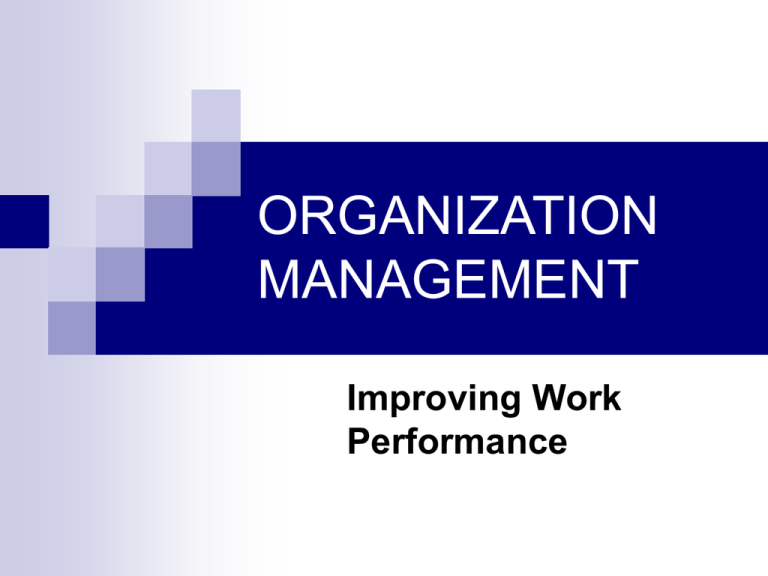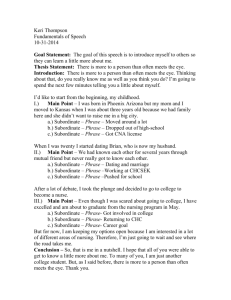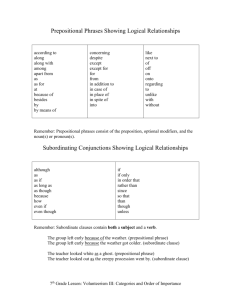BA 550 6 Improving Work Performance
advertisement

ORGANIZATION MANAGEMENT Improving Work Performance As a manager . . . you don’t get paid for what you do you get paid for what your subordinates do You are a manager with 10 people answering directly to you. What will be accomplished tomorrow if: a. You take the day off, but all 10 people in your group go to work b. You go to work, but all 10 people in your group take the day off You need them more than they need you You should do everything in your power to help them be as successful as possible There is a performance problem You: “I don’t think Charley is going to work out. I think we made a poor hire.” Your boss: “ How long will it take to get his replacement?” Attitude Consequences Behavior Behavior Mowing the lawn today Positive Consequences Negative Consequences + Lawn looks nice – Don’t play golf today + Easier to do because grass is not too long – Perspire in hot sun + Neighbors tell you how nice it looks – Physical effort Undesirable Task (monthly) - In January, I gave it to Lou. He totally screwed it up. - In February, I gave it to Angela. She did the best job anyone has ever done. - In March, I will give it to . . . Why Don’t Subordinates Do What They Are Supposed To Do? 1. They don’t know what they are supposed to do 2. They don’t know how to do it 3. They don’t know why they should 4. There are obstacles beyond their control 5. They don’t think it will work 6. They think their way is better 7. Not motivated – poor attitude 8. Personally incapable of doing it (personal limits) 9. Not enough time for them to do it 10. They are working on wrong priority items 11. They think they are doing it (no feedback) 12. Poor management 13. Personal problems Why Don’t Subordinates Do What They Are Supposed To Do? 1. They don’t know what they are supposed to do 2. They don’t know how to do it 3. They don’t know why they should 4. There are obstacles beyond their control 5. They don’t think it will work 6. They think their way is better 7. Not motivated – poor attitude 8. Personally incapable of doing it (personal limits) 9. Not enough time for them to do it 10. They are working on wrong priority items 11. They think they are doing it (no feedback) 12. Poor management 13. Personal problems Communication Problem “This is important. Really, really important” • He thinks it’s important – I think it’s boring • Is that an ugly tie, or what? • That was a great movie last night • I hope traffic isn’t too bad tonight • How many martinis did he have for lunch? • I’m hungry Two-Part Communication Process 1. Ask a question 2. Shut up “Thought Transmission” Coaching Analysis Identify unsatisfactory performance Is it worth your time and effort? YES Does subordinate know performance is unsatisfactory? YES Does subordinate know what is supposed to be done and when? YES Are there obstacles beyond subordinate’s control? NO Does subordinate know how to do it? NO NO NO YES NO Don’t waste your time on it Let subordinate know – provide feedback Let subordinate know – work planning Remove obstacles Train subordinate and/or provide practice YES Does negative consequence follow performance? NO Does positive consequence follow nonperformance? NO Could subordinate do it if he or she wanted to do it? YES Redirect subordinates behavior through coaching YES YES NO Change consequences or transfer subordinate Change consequences Transfer or terminate subordinate Identify unsatisfactory performance Is it worth your time and effort? NO Don’t waste your time on it YES Performance – focus on behaviors, not the results of the behaviors Why Otherwise, they don’t know what to change Able to measure (so you can recognize if it’s getting better or worse) Does subordinate know performance is unsatisfactory? NO Let subordinate know – provide feedback YES An estimated 50% of non-performance problems in business are due to the lack of feedback ? ? ? Do you know what your error rate is? Do you know that you frequently interrupt people in meetings? Do you know that you begin to mumble after you get a minute or two into presentations? Note: They could know that the behavior exists, and not know that it’s a problem Does subordinate know what is supposed to be done and when? NO Let subordinate know – work planning YES Number one issue on list “Why don’t subordinates do what they are supposed to” Common problem in creative areas with complex work: What is it supposed to look like when it’s finished? Complaint: assistant does not analyze situations in depth to reach solutions or suggest alternatives Approach: manager and assistant work together to develop a list of key questions that should be addressed in all reports Are there obstacles beyond subordinate’s control? NO Does subordinate know how to do it? YES NO Remove obstacles Train subordinate and/or provide practice YES Number two issue on list “Why don’t subordinates do what they are supposed to” Common problems Experienced employees assigned to train new employees – trainers have not been taught how to teach Lack of testing and/or opportunities for application – trainees are not required to demonstrate learning Does negative consequence follow performance? NO Does positive consequence follow nonperformance? YES YES Change consequences or transfer subordinate Change consequences NO Behavior is a function of its consequences Avoid negative consequences – they can have undesirable side effects Positive consequences should be: Relevant Direct Immediate Could subordinate do it if he or she wanted to do it? NO Transfer or terminate subordinate YES Redirect subordinates behavior through coaching Usually the first question asked, and answered, “Of course the _____ could do it if he’d get off his rear end!” Should be addressed when you have determined: They know their performance is not satisfactory They know what is supposed to be done and when There are no obstacles beyond his or her control They know how to do it A negative consequence does not follow performance A positive consequence does not follow nonperformance Coaching Analysis Identify unsatisfactory performance Is it worth your time and effort? YES Does subordinate know performance is unsatisfactory? YES Does subordinate know what is supposed to be done and when? YES Are there obstacles beyond subordinate’s control? NO Does subordinate know how to do it? NO NO NO YES NO Don’t waste your time on it Let subordinate know – provide feedback Let subordinate know – work planning Remove obstacles Train subordinate and/or provide practice YES Does negative consequence follow performance? NO Does positive consequence follow nonperformance? NO Could subordinate do it if he or she wanted to do it? YES Redirect subordinates behavior through coaching YES YES NO Change consequences or transfer subordinate Change consequences Transfer or terminate subordinate Coaching Technique Get his or her agreement that a problem exists Mutually discuss alternative solutions Mutually agree on action to be taken to solve problem Follow up to measure results Recognize any achievement when it occurs Agreement That a Problem Exists Most critical step of the coaching process – can take up to half the total time Most coaching efforts fail here – step is bypassed, assuming the subordinate knows Important to recognize Effects on the business/others – results Effects on self – consequences Get his or her agreement that a problem exists Mutually discuss alternative solutions Mutually agree on action to be taken to solve problem Follow up to measure results Use thought transmission Recognize any achievement when it occurs The Conversation • Do you know why I’ve called up in? • No • We have a problem. • What problem? • It’s about your performance. • What about my performance? I thought I was doing pretty good. I turn out a lot of work around here. • It has to do with your not coming to work on time. • Oh that. Yeah, I know I’ve been late a few times. I’ll clean it up. • Do you know how many times you’ve been late in the last month? • Probably more than I should, but like I said, I’ll take care of that. • I’m glad you are willing to take care of that, but do you know how many times you’ve been late? • I have no idea • Guess. • Probably once or twice a week. The Conversation . . . Continued • You were on time only 40 percent of the time – that averages three days per week you were late. • I didn’t realize it was that many days. • Do you agree that it is a problem? • I agree it’s a lot of days, but after all I work harder than anybody else, so it all evens out. • Do you know what happens when you don’t come to work on time? • Well, I guess you get mad at me. • Not mad, just disappointed. Do you know what else happens? • Well, I heard some grumbling that others don’t like answering my phone when I’m late for work. • You’re right. What else happens? • Well, I guess some customers don’t like it when they can’t get me first thing in the morning. The Conversation . . . Continued • You’re right. What else happens? • I can’t think of anything else. • There’s no rush. I’ll wait while you think about it. • I really can’t think of anything else. • Do you think customers ever complain to me or to my boss? • Well, I guess that is a problem, but I work harder and get more done than anybody else. • What do you think will happen if you continue to come to work late? • I guess customers will complain and you might fire me. • You’re right. I need somebody in that job who will do what has to be done, and I wish it were you. Now do you agree that this is a problem? • Well, when you put it all together, I suppose it is a problem. • I’m glad that you recognize the problem. How can we solve it? Step 2 Mutually Discuss Alternative Solutions / Mutually Agree on Action Trying harder is not a solution – what will the individual do differently Agreement what will be done when Use thought transmission Get his or her agreement that a problem exists Mutually discuss alternative solutions Mutually agree on action to be taken to solve problem Follow up to measure results Recognize any achievement when it occurs Follow Up to Measure Results / Recognize Any Achievement Lack of follow up is a common reason for failure Sometimes, subordinate initially changes, but lack of follow up does not reinforce the new behavior Timeliness of recognition is critical Important to recognize progress even when it is short of the goal ? Get his or her agreement that a problem exists Mutually discuss alternative solutions Mutually agree on action to be taken to solve problem Follow up to measure results Recognize any achievement when it occurs Giving Effective Feedback Relate feedback to existing performance goals and clear expectations Give specific feedback (observable behavior and measurable results) Give feedback as soon as possible Give positive feedback for improvements, not just final results Focus on performance, not personalities Base feedback on accurate and credible information To improve performance of the individual and the work unit Formula for Failure Don’t get the subordinate involved, just talk at him or her Don’t give specific feedback – talk in generalities Concentrate on attitude rather than behavior Assume the subordinate understands that a problem exists Assume the subordinate knows what has to be done to solve the problem Don’t follow up to ensure that agreed upon action has been taken Don’t acknowledge or praise improvement






